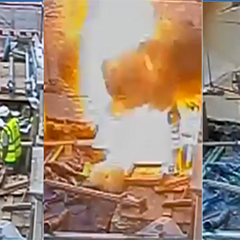Cable strikes are not uncommon. Out of an estimated 4 million excavations in the UK annually, it’s believed that there are approximately 60,000 cable strikes[i]. These strikes occur when machinery or tools come into contact with a live cable and expose workers to risks including electrocution and devastating Arc Flash explosions.
These incidents can result in fatalities and life changing injuries to workers involved. With so many of these incidents taking place across the UK, it’s essential that anyone breaking ground is equipped with Arc Flash training and the right Arc Rated PPE. Here, Mark Lant, technical sales manager at ProGARM, the UK’s leading provider of specialist Arc Flash PPE, offers important advice for those at risk.
Arc Flash incidents often go unrecorded, as people mistake them for a severe electric shock. As such, there isn’t as much awareness around the true dangers of a cable strike as there should be. Even more alarmingly ProGARM research shows that there is little understanding of what an Arc Flash is, and how people can best protect themselves.
As such thousands of workers across the UK are heading out to site ill-equipped to prevent and protect against an Arc Flash occurring. Considering the true scale of those at risk, this is a huge issue that must be addressed. According to The Utility Strike Avoidance Group[ii], activity that creates risk of a strike can be incredibly varied and include everything from ground work carried out by contractors, to fencing, housebuilding, piling and industrial activity.
With so many sectors impacted, and little understanding between the important differences between an Arc Flash incident and an electric shock, there’s little wonder this hidden killer is going unnoticed.
The difference between an Arc Flash and electric shock
Understanding the differences between electrocution and Arc Flash injuries is the first step to saving lives. Knowing why you need different protection from the two types of incident, means that workers are saved from being sent out to site in inappropriate PPE.
Being electrocuted is very different from what happens when you experience an Arc Flash. Electrocution can cause a wide range of injuries. From just creating a tingling in the part of your body where the electric current enters, to causing death – the spectrum of injuries is broad.
In contrast an Arc Flash incident throws both a huge amount of thermal energy out, along with a strong blast that acts like an explosion.
Injuries can result from getting hit by the thermal energy or getting caught in the blast.
The energy in Arc Flash incidents can generate temperatures exceeding 35,000 Fahrenheit – that’s four times hotter than the sun – and can affect people standing many metres away from the source.
Arc Flash injuries can include:
- 1st, 2nd or 3rd degree burns to the body, but also to the throat, mouth or lungs from inhaling metal vaporised by the heat. Burns to the body can be made worse by not wearing appropriate PPE as synthetic clothing can melt on to skin, even without outer workwear setting on fire
- Shrapnel injuries from flying debris
- Broken bones, concussion or muscle injuries from being thrown back by the blast or falling, if you’re working at height
- Hearing loss or ruptured ear drums from the sound of the blast
- Flash burns to eyes, caused by the UV light emitted by the flash of the Arc Flash incident
Preventing Arc Flash and electrocution injuries
Good risk assessments, safe working practices and general health and safety awareness are good first steps in preventing both Arc Flash and electrocution injuries. But as either kind of injury could be life-limiting or life-ending, specialist personal protective equipment (PPE) is also needed, especially in the case of Arc Flash incidents.
It’s important that you ensure PPE protects workers from Arc Flash injuries in a number of ways:
- Each garment is rated according to the scale of Arc Flash incident energy it can protect from, indicating the level of protection the fabric and other component parts will provide. An Arc Flash study and risk assessment will recommend the appropriate cal-rating for the task a worker is completing
- The protection provided by the fabrics should be inherent to them, not added afterwards via chemical treatment, so it can’t wash out or deteriorate over time
- The garments should feature ThermSAFE fastenings, to ensure they will not melt in an Arc Flash incident, meaning, if necessary, workers can take off clothing to have injuries treated
- Synthetic base layers, socks or underwear could melt on to the skin even without outer clothes setting on fire, so base layers and under-garments are also critical to protection and every garment should be FR/Arc rated
There’s no disputing the danger posed by arc flash incidents. With so many cable strikes occurring in the UK each day, it’s vital that those breaking ground, be it utilities, construction or ground engineering, take the necessary precautions to protect workers and save lives.
For more information, visit www.progarm.com/arc-flash-protection/
ProGARM is dedicated to protecting lives through the manufacture and supply of exceptional quality Arc Flash and Flame Resistant safety clothing.
Based in East Yorkshire, ProGARM’s key goal is to educate about the dangers of Arc Flash whilst providing an exceptional Arc Flash clothing range that offers the ultimate in protection.
ProGARM is the only UK manufacturer concentrating on and specialising 100% in Arc Flash and Flame Resistant garments for businesses. The company prides itself in consistently innovating and in having specialist expertise available for those it works with.
Recognised as the brand that people see as the leader in Arc Flash, ProGARM delivers an exceptional service, whilst remaining vibrant, strong and hungry to pioneer the very best Arc Flash PPE.
Follow ProGARM on Twitter – @ProGARMSafety



























